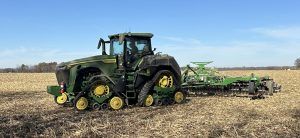The Spring Quandary
By Lindsay Humphrey and Chris Peacock
“Soil compaction is the gift that keeps on giving.” – Bob Nielsen, Purdue University Agronomy Professor (retired)
One decision today could easily lead to disaster for several planting seasons in the future. Planting season in Indiana typically runs from the middle of April through late May but can quickly run into early June. At least that’s what Purdue University said about the corn crop in the state after looking at data from the past 20 years. The details can be found by clicking here. Weather is the leading factor in a planting plan’s stop-and-go nature, regardless of state. Planting early is incentivized for several reasons but also chastised at the same time.
In Indiana, crop insurance holds the reins on early planting for corn and soybeans. April 10 is the earliest date corn can go in the ground if a farmer wants that crop to qualify for replanting coverage if it gets damaged. For soybeans, that date is April 24. However, the final cutoff for planting corn under the crop insurance umbrella is June 5 and June 20 for soybeans. (Source: Famers Mutual Insurance Agency Inc.)
“Spring is the best time to discuss compaction because it’s when farmers are itching to get out in the field and start planting,” said Chris Peacock, an associate broker and senior accounts manager for Halderman. “The long-lasting effects of soil compaction versus a hypothetical higher yield is a real challenge for farmers, especially when there are incentives to get crops in early at the risk of compacting the soil because it’s just too damp.”
Every pass through the field can easily be detrimental to the root health of future crops. Anyone who took a crop science course with a passionate professor will likely know that soil and dirt are very different. While soil is alive and active, dirt is simply dead. Dirt lacks the essential nutrients, minerals, and living organisms that make the soil a conduit for life. Roughly 45 percent of soil is made up of minerals, which include sand, silt, and clay – all of which tell a farmer a whole lot about the growing potential of their ground. Soil testing has a place in preventing and even treating compaction issues.

Twenty-five percent of soil comprises water, another 25 percent is air, and the final five percent is organic matter. Understanding what’s going on below your boots and tires is important because it will determine everything that happens above ground. Purdue University defines compaction as “the moving of soil particles closer together by external forces such as falling rain, livestock traffic, and the weight of farm equipment. Compaction increases the bulk density (weight per volume) and decreases pore space between soil particles.”
Soil porosity is essential for growing crops because, without water and air, plants can’t grow. Soil may still be porous even when it’s compacted, but it’s undoubtedly restricting the potential of that crop. (Insert figure 1: Compaction Comparison Chart)
“One farmer may think the soil is too wet while another farmer may go ahead and work the ground without realizing they’re damaging the soil,” Peacock said. “It would be great if we had some technology to tell us when to be out in the field and when not.”
Compacted soil will significantly reduce the root depth of a plant, which means that the corn and beans won’t have as much access to groundwater and nutrients. (Insert figure 2: Soil Root Comparison Chart) If you think your soil is compacted, there’s plenty to be done to correct it. The hard part, however, is identifying it.
“When the soil is compacted, plant roots can’t get deep enough to reach nutrients or water,” Peacock said. “That can look like a nutrient deficiency issue above ground, and farmers might try using variable rate application to address the issue, but it’s caused by compaction. The effects of compaction can also look like the plants sustained a herbicide injury.”
The worst symptom of compaction is a reduced yield. Unfortunately, a low yield doesn’t automatically mean your field is compacted, but it should be one of the questions asked when crunching the numbers at the end of the year.
“As farms grow larger with more acres to cover in the same amount of time, compaction becomes a larger problem,” Peacock added. “More acres usually require bigger, heavier equipment.”
Managing compaction and avoiding it all together is a tricky balancing act. As technology advances, it’s easy to forget about some more straightforward approaches. 
“More farmers use cover crops like turnips and radishes because their roots can penetrate the compacted soil and break it up,” Peacock said. “I’ve also noticed more rubber tracks and flotation tires versus conventional tires on some equipment; anything to spread the weight of the equipment over a larger area. Some farmers also travel on the same tracks every time they pass through a field. Others utilize inflatable tires that can deflate when they’re in the field, which helps spread the weight over a greater area, and then reinflate when heading to the next field.”
Knowing the soil drainage of each field is essential for many things as a farmer, but it can also help inform your decisions about when to get into a field and when to wait. It pays to be patient for most springs, even though that is very difficult for many farmers.
Here’s a simple test presented by Successful Farming to determine if your field is too wet for planting: https://www.agriculture.com/news/machinery/avoid-desire-to-plant-to-wet
And never forget the importance of soil testing: https://www.farmers.gov/sites/default/files/2022-09/farmersgov-small-scale-factsheet-soil-testing-9-2022.pdf
